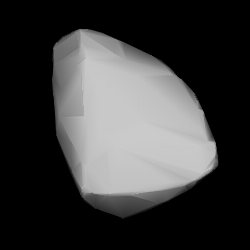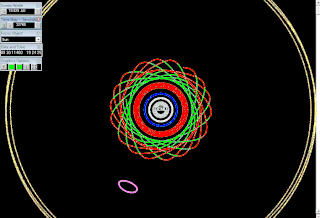Related Research Articles

3325 TARDIS is a dark Alauda asteroid from the outer region of the asteroid belt, approximately 29 kilometers in diameter. It was discovered on 3 May 1984, by American astronomer Brian Skiff at Lowell's Anderson Mesa Station, Arizona, in the United States. The asteroid was named TARDIS, after the fictional time machine and spacecraft from the science fiction television series Doctor Who.

Brasilia is a large Main belt asteroid that was discovered by French astronomer Auguste Charlois on 20 May 1890 in Nice. It is the namesake of the Brasilia family, a smaller asteroid family of X-type asteroids in the outer main-belt. However, Brasilia is a suspected interloper in its own family.

Phaeo is an asteroid from the central regions of the asteroid belt, approximately 70 kilometers in diameter. It was discovered on 27 November 1891, by French astronomer Alphonse Borrelly at the Marseille Observatory in southern France. The presumably metallic X-type asteroid is the principal body of the Phaeo family and has a rotation period of 17.6 hours. It was named for the Greek mythological figure Phaeo, one of the Hyades or nymphs. Several other asteroids were named for other of the Hyades – 106 Dione, 158 Koronis, 217 Eudora, and 308 Polyxo.
Praxedis, provisional designation 1904 PB, is a Postremian asteroid from the central regions of the asteroid belt, approximately 52 kilometers in diameter.
892 Seeligeria is dark Alauda asteroid from the outer region of the asteroid belt that was discovered by German astronomer Max Wolf on May 31, 1918 in Heidelberg and assigned a preliminary designation of 1918 DR. It was named after German astronomer Hugo Hans von Seeliger.
1370 Hella, provisional designation 1935 QG, is a stony Florian asteroid from the inner regions of the asteroid belt, approximately 5.4 kilometers in diameter. It was discovered on 31 August 1935, by astronomer Karl Reinmuth at the Heidelberg-Königstuhl State Observatory in southwest Germany. The asteroid was named for Helene Nowacki, an astronomer at the Astronomical Calculation Institute.
10245 Inselsberg, provisional designation 6071 P-L, is a Gefion asteroid from the central regions of the asteroid belt, approximately 7 kilometers in diameter. It was discovered on 24 September 1960, by Ingrid and Cornelis van Houten at Leiden, and Tom Gehrels at Palomar Observatory in California, United States. The likely S-type asteroid was named for the German mountain Großer Inselsberg.

5222 Ioffe, provisional designation 1980 TL13, is a rare-type carbonaceous Palladian asteroid from the central region of the asteroid belt, approximately 18 kilometers in diameter. It was discovered on 11 October 1980, by Soviet astronomer Nikolai Chernykh at the Crimean Astrophysical Observatory in Nauchnyj, Crimea. It is the largest of the Palladian asteroids apart from Pallas itself.
4525 Johnbauer, provisional designation 1982 JB3, is dark Mitidika asteroid from the central regions of the asteroid belt, approximately 10 kilometers in diameter. It was discovered on 15 May 1982, by astronomer couple Eleanor and Eugene Shoemaker, as well as Peter Wilder at the Palomar Observatory in California, United States. The asteroid was named after John Bauer, physics teacher at San Diego City College.
1287 Lorcia, provisional designation 1933 QL, is an Eoan asteroid from the outer regions of the asteroid belt, approximately 22 kilometers in diameter. It was discovered by Belgian astronomer Sylvain Arend at the Royal Observatory of Belgium in Uccle on 25 August 1933. The asteroid was named for Laura de Sołohub Dikyj, wife of Polish astronomer Tadeusz Banachiewicz.
21509 Lucascavin, provisional designation 1998 KL35, is a small asteroid from the inner regions of the asteroid belt, approximately 2.5 kilometers (1.6 miles) in diameter. It is the namesake of the tiny Lucascavin family located within the Flora clan. It was discovered on 22 May 1998, by astronomers with the Lincoln Near-Earth Asteroid Research at the Lincoln Laboratory's Experimental Test Site near Socorro, New Mexico. The presumed S-type asteroid has a rotation period of 5.8 hours. It was named for the 2005-ISEF awardee Lucas James Cavin.
1410 Margret, provisional designation 1937 AL, is an Eoan asteroid from the outer regions of the asteroid belt, approximately 21 kilometers in diameter. It was discovered on 8 January 1937, by astronomer Karl Reinmuth at the Heidelberg Observatory in southwest Germany. The asteroid was named after Margret Braun, wife of the Heidelberg astronomer Heinrich Vogt.
2905 Plaskett, provisional designation 1982 BZ2, is a stony Gefionian asteroid from the central regions of the asteroid belt, approximately 10 kilometers in diameter. It was discovered on 24 January 1982, by American astronomer Edward Bowell at the Anderson Mesa Station near Flagstaff, Arizona. The asteroid was named after Canadian astronomers John Stanley Plaskett and Harry Hemley Plaskett.

1312 Vassar, provisional designation 1933 OT, is a carbonaceous Alauda asteroid from the outer region of the asteroid belt, approximately 30 kilometers in diameter. It was discovered on 27 July 1933, by Belgian–American astronomer George Van Biesbroeck at Yerkes Observatory in Wisconsin, United States. The asteroid was named for the American Vassar College.
2732 Witt, provisional designation 1926 FG, is a bright asteroid and namesake of the Witt family located in the central regions of the asteroid belt, approximately 11 kilometers in diameter. It was discovered on 19 March 1926, by German astronomer Max Wolf at the Heidelberg-Königstuhl State Observatory in Heidelberg, Germany. The unusual A-type asteroid was named after astronomer Carl Gustav Witt.
51983 Hönig, provisional designation 2001 SZ8, is a Hildian asteroid from the outermost regions of the asteroid belt, approximately 13 kilometers in diameter. It was discovered on 19 September 2001, by astronomers Charles Juels and Paulo Holvorcem at the Fountain Hills Observatory (678) in Arizona, United States. The asteroid was named after German astronomer Sebastian Hönig.
10140 Villon, provisional designation 1993 SX4, is a Nysian asteroid from the inner regions of the asteroid belt, approximately 5 kilometers (3 miles) in diameter. It was discovered on 19 September 1993, by Belgian astronomer Eric Elst at the CERGA Observatory at Caussols in France. It was named after 15th-century French poet François Villon.
164589 La Sagra, provisional designation 2007 PC11, is an asteroid of the Euterpe family from the inner regions of the asteroid belt, approximately 1.2 kilometers (0.75 miles) in diameter. It was discovered on 11 August 2007, by astronomers of the Astronomical Observatory of Mallorca at its robotic La Sagra Observatory in Grenada, Spain. It was named after Mount La Sagra and the discovering La Sagra Observatory.
116903 Jeromeapt – provisional designation 2004 GW – is an asteroid of the Massalia family from the inner regions of the asteroid belt, approximately 1.1 kilometers in diameter. It was discovered on 11 April 2004, by American astronomer Jim Young at the Table Mountain Observatory near Wrightwood, California, in the United States. The asteroid was named for American astronaut Jerome Apt.
185638 Erwinschwab, provisional designation 2008 EU7, is a potentially sub-kilometer Nysian asteroid from the inner regions of the asteroid belt. It was discovered on 1 March 2008, by OAM-astronomers at the La Sagra Observatory in southern Spain. The asteroid is estimated to measure between 950 meters and 1.8 kilometers in diameter and was named after German astronomer Erwin Schwab in 2009.
References
- 1 2 "Asteroid 581 Tauntonia – Nesvorny HCM Asteroid Families V3.0". Small Bodies Data Ferret. Retrieved 24 October 2019.
- 1 2 3 4 5 6 7 "581 Tauntonia (1905 SH)". JPL Small-Body Database . NASA/Jet Propulsion Laboratory . Retrieved 5 May 2016.
- ↑ Nesvorný, D.; Broz, M.; Carruba, V. (December 2014). "Identification and Dynamical Properties of Asteroid Families". Asteroids IV. pp. 297–321. arXiv: 1502.01628 . Bibcode:2015aste.book..297N. doi:10.2458/azu_uapress_9780816532131-ch016. ISBN 9780816532131. S2CID 119280014.